A Spatial Typography of Environmentally Friendly Common Agricultural Policy Support Relevant to European Green Deal Objectives
Abstract
:1. Introduction
2. Materials and Methods
2.1. Scope and Data
- -
- organic farming (O)—one package: the RDP 2014–20 measure;
- -
- environmental farming (E)—four AECM packages in total: sustainable agriculture; protection of soils and waters; preservation of traditional orchards; preservation of endangered plant genetic resources in agriculture;
- -
- habitat farming (H)—two AECM packages in total: valuable habitats and endangered bird species in Natura 2000 areas; valuable habitats outside Natura 2000 areas.
2.2. Methods
2.3. Identification of Determinants: Planes for the Evaluation of Pro-Environmental Payments
- -
- less favoured areas (LFA), as % of total area (according to ARMA, as of 2019);
- -
- protected areas, as % of total area (according to BDL GUS, as of 2019);
- -
- soils of the lowest soil quality classes (V, VI), as % of UAA (according to IUNiG, as of 2010).
- -
- average farm area (according to ARMA): because payment sizes depend on UAA, this is an important financial stimulus in the adoption of agri-environmental obligations.
- -
- share of farm managers with higher education (according to PSR 2010): educational level affects the level of ecological awareness, and is relevant to green activities in agriculture.
- -
- level of land productivity (total agricultural production in PLN per 1 ha of UAA): a determinant of the extensification of agricultural production. Land productivity was calculated by multiplying the areas of specific crops by the 2010 Standard Output (SO) coefficient. Standard Output is calculated by Poland’s Institute of Agricultural and Food Economics National Research Institute (Instytut Ekonomiki Rolnictwa i Gospodarki Żywnościowej—Państwowy Instytut Badawczy) as the 5-year average of production per hectare of crop in regional average production conditions.
3. Results
3.1. Determinants of Green Agricultural Development in Poland
3.2. Farmlands Subsidised for Implementing the Pro-Environmental Obligations of RDP 2014-20
3.3. Breakdown of Farmland by Type of Pro-Environmental RDP Payments
- -
- sustainable agriculture: total in Polandc.268,100 ha (fromc.800 ha in Lesser Poland up toc.47,400 ha in Kuyavia-Pomerania) (see Figure 4a);
- -
- protection of soils and waters: totalc.129,000 ha (from 2100–2200 ha in the provinces of Lesser Poland, Subcarpathia and Silesia up toc.22,200 ha in Pomerania) (see Figure 4b);
- -
- preservation of traditional tree orchards: 565 ha in total (from 3 ha in Opole Province to 134 ha in Lesser Poland) (see Figure 4c);
- -
- preservation of endangered plant genetic resources in agriculture: a total of c.11,000 ha (from zero in Opole Province toc.2800 ha in Lublin Province) (see Figure 4d).
- -
- valuable bird habitats and endangered bird species in Natura 2000 areas: total ofc.258,700 ha (fromc.600 ha in Silesia Province andc.900 ha in Opole Province toc.52,400 ha in Western Pomerania);
- -
- valuable habitats outside Natura 2000 areas: total ofc.197,200 ha (fromc.1500 in Opole Province toc.34,100 ha in Warmia-Masuria).
3.4. Typology of Pro-Environmental Forms of CAP Support
- -
- organic farming—three provinces: Podlasie, Warmia-Masuria and West Pomerania (type E2—all with three quotients);
- -
- environmental agriculture—eight provinces: two of type R1 (Kuyavia-Pomerania—six R quotients, Opole—five R quotients) and six of type R2 (three R quotients for Lublin, Łódź, Silesia, Holy Cross and Greater Poland; and four R quotients for Pomerania);
- -
- habitat farming—four provinces: one of type S1 (Subcarpathia—five quotients) and three of type S2 (Lower Silesia, Lubusz, Lesser Poland—three quotients; see Table 3).
- -
- organic type (O): national average 21.3%, including the highest number in the provinces of Lesser Poland—33.3%, Podlasie—37.3% and, above all, in Warmia-Masuria—53.3%;
- -
- environmental type (E): national average 41.5%, including the most in the provinces of Kuyavia-Pomerania—83.2%, Lublin—52.2%, Łódź—62.2%, Opole—81.6%, Pomerania—63.9% and Greater Poland—72.4%;
- -
- habitat type (H): national average 27.7%, including the largest number in the provinces of Lower Silesia—45.6%, Lubusz—48.7%, Podlasie—37.3% and, above all, Subcarpathia—60.1%;
- -
- equal share (ES): national average 8.8%, including the highest number in the provinces of Lubusz—17.9% and Warmia-Masuria—15.2% (see Figure 7).
4. Discussion
5. Conclusions
- -
- ecological: the need to intensify activities aimed at growing this land category due to current trends in the development of farms being promoted by, among others, the EGD;
- -
- environmental: the need to more heavily promote pro-environmental practices in agriculture, especially in environmentally valuable areas covered by various forms of protection (including legal protection);
- -
- habitat: the need to regulate the status of farms that have valuable natural habitats of key importance in terms of protecting nature and biodiversity and that are not used for producing food using natural substances and processes (the main characteristic of organic farming).
Author Contributions
Funding
Institutional Review Board Statement
Informed Consent Statement
Data Availability Statement
Conflicts of Interest
Appendix A
| Packages/Variants | RDP Green Measures in Agriculture: Total | Thousand ha | % |
|---|---|---|---|
| 1284.9 | 100.0 | ||
| Agri-environmental–climate measure (AECM) | 864.5 | 67.3 | |
| I | Sustainable agriculture | 268.1 | 20.9 |
| II | Protection of soils and waters | 129.0 | 10.0 |
| II.1 | Catch crops | 128.9 | 10.0 |
| II.2 | Protective strips on slopes steeper than 20% | 0.0 | 0.0 |
| III | Preserving orchards of traditional fruit tree varieties | 0.6 | 0.0 |
| IV | Valuable bird habitats and endangered bird species in Natura 2000 areas | 258.7 | 20.1 |
| IV.1 | Variable-humidity tall meadows | 5.3 | 0.4 |
| IV.2 | Alluvial Cnidiondubii meadows and salt meadows | 4.1 | 0.3 |
| IV.3 | Grasslands | 4.7 | 0.4 |
| IV.4 | Semi-natural humid meadows | 33.0 | 2.6 |
| IV.5 | Semi-natural Arrhenatherion meadows | 69.0 | 5.4 |
| IV.6 | Bogs | 6.7 | 0.5 |
| IV.6.1 | Peatlands—mandatory requirements | 0.8 | 0.1 |
| IV.6.2 | Peatlands—mandatory and supplementary requirements | 5.9 | 0.5 |
| IV.7 | Extensive land use in special bird protection areas (SPAs) | 27.0 | 2.1 |
| IV.8 | Protection of breeding habitats of black-tailed godwit, common snipe, redshank or lapwing | 83.8 | 6.5 |
| IV.9 | Protection of breeding habitats of aquatic warbler | 8.1 | 0.6 |
| IV.10 | Protection of breeding habitats of great snipe or common curlew | 12.5 | 1.0 |
| IV.11 | Protection of breeding habitats of corncrake | 4.5 | 0.4 |
| V | Valuable habitats outside Natura 2000 areas | 197.2 | 15.4 |
| V.1 | Variable-humidity tall meadows | 6.0 | 0.5 |
| V.2 | Alluvial Cnidiondubii meadows | 1.0 | 0.1 |
| V.3 | Grasslands | 8.5 | 0.7 |
| V.4 | Semi-natural humid meadows | 72.2 | 5.6 |
| V.5 | Semi-natural Arrhenatherion meadows | 106.4 | 8.3 |
| V.6 | Bogs | 3.1 | 0.2 |
| V.6.1. | Peatlands—mandatory requirements | 0.4 | 0.0 |
| V.6.2. | Peatlands—mandatory and supplementary requirements | 2.7 | 0.2 |
| VI | Preservation of endangered plant genetic resources in agriculture | 11.0 | 0.9 |
| VI.1 | Preservation of endangered plant genetic resources in agriculture—crop farming | 9.4 | 0.7 |
| VI.2 | Preservation of endangered plant genetic resources in agriculture—seed material or seed production | 1.6 | 0.1 |
| VII | Organic farming (OF) | 420.4 | 32.7 |
| VII.1 | Payments during conversion period | 95.2 | 7.4 |
| VII.1.1 | Crops during conversion period | 49.5 | 3.9 |
| VII.1.2 | Vegetable crops during conversion period | 6.5 | 0.5 |
| VII.1.3 | Herbaceous crops during conversion period | 7.0 | 0.5 |
| VII.1.4 | Fruit crops during conversion period | 5.8 | 0.5 |
| VII.1.4.1 | Basic fruit crops during conversion period | 2.1 | 0.2 |
| VII.1.4.2 | Berry crops during conversion period | 2.5 | 0.2 |
| VII.1.4.3 | Extensive fruit crops during conversion period | 1.1 | 0.1 |
| VII.1.5 | Fodder crops during conversion period | 18.2 | 1.4 |
| VII.1.6 | Permanent pasture during conversion period | 8.3 | 0.6 |
| VII.2 | Post-conversion payments | 325.1 | 25.3 |
| VII.2.1 | Post-conversion crops | 151.9 | 11.8 |
| VII.2.2 | Post-conversion vegetable crops | 17.1 | 1.3 |
| VII.2.3 | Post-conversion herb crops | 16.4 | 1.3 |
| VII.2.4 | Post-conversion fruit crops | 0.0 | 0.0 |
| VII.1.4.1 | Post-conversion basic fruit crops | 2.5 | 0.2 |
| VII.1.4.2 | Berry crops during conversion period | 9.9 | 0.8 |
| VII.1.4.3 | Post-conversion extensive fruit crops | 3.1 | 0.2 |
| VII.1.5 | Post-conversion fodder crops | 89.4 | 7.0 |
| VII.1.6 | Post-conversion permanent pasture | 34.9 | 2.7 |
References
- Bateman, I.J.; Balmford, B. Public funding for public goods: A post-Brexitperspective on principles for agricultural policy. Land Use Policy 2018, 79, 293–300. [Google Scholar] [CrossRef]
- Treasury, H.M. The Green Book: Central Government Guidance on Appraisal and Evaluation. London, UK. 2018. Available online: https://assets.publishing.service.gov.uk/government/uploads/system/uploads/attachment_data/file/685903/The_Green_Book.pdf (accessed on 20 September 2021).
- Ecorys. Mapping and Analysis of the Implementation of the CAP. 2017. Available online: https://op.europa.eu/pl/publication-detail/-/publication/65c49958-e138-11e6-ad7c-01aa75ed71a1 (accessed on 22 August 2021).
- Wiśniewski, Ł.; Rudnicki, R.; Chodkowska-Miszczuk, J. What non-natural factors are behind the underuse of EU CAP funds in areas with valuable habitats? Land Use Policy 2021, 108, 105574. [Google Scholar] [CrossRef]
- Marsden, T.; Sonnino, R. Rural development and the regionalstate: Denyingmultifunctionalagriculture in the UK. J. RuralStud. 2008, 24, 422–431. [Google Scholar] [CrossRef]
- Hanley, N.; Banerjee, S.; Lennox, G.D.; Armsworth, P.R. How shouldweincentivizeprivatelandowners to ‘produce’ morebiodiversity? Oxf. Rev. Econ. Policy 2012, 28, 93–113. [Google Scholar] [CrossRef]
- Home, R.; Balmer, O.; Jahrl, I.; Stolze, M.; Pfiffner, L. Motivations for implementation of ecologicalcompensationareas on Swiss lowlandfarms. J. Rural Stud. 2014, 34, 26–36. [Google Scholar] [CrossRef]
- Kleijn, D.; Sutherland, W.J. How effectiveareEuropeanagri-environment schemes in conserving and promotingbiodiversity? J. Appl. Ecol. 2003, 40, 947–969. [Google Scholar] [CrossRef]
- Pe’er, G.; Zinngrebe, Y.; Moreira, F.; Sirami, C.; Schindler, S.; Müller, R.; Hansjürgens, B. A greenerpath for the EU common agricultural policy. Science 2019, 365, 449–451. [Google Scholar] [CrossRef]
- European Commission. Communication from the Commission to the European Parliament, the European Council, the Council, the European Economic and Social Committee and the Committee of the Regions, The European Green Deal, COM (2019) 640 Final; European Commission: Brussels, Belgium, 2019. [Google Scholar]
- Jaeger, C.; Mielke, J.; Schütze, F.; Teitge, J.; Wolf, S. The European Green Deal—More Than Climate Neutrality. Intereconomics 2021, 56, 99–107. [Google Scholar] [CrossRef]
- European Commission. Communication from the Commission to the European Parliament, the Council, the European Economic and Social Committee and the Committee of the Regions. Sustainable Europe Investment Plan. European Green Deal Investment Plan, COM(2020) 21 Final; European Commission: Brussels, Belgium, 2020. [Google Scholar]
- European Commission. Communication from the Commission to the European Parliament, the Council, the European Economic and Social Committee and the Committee of the Regions. A Farm to Fork Strategy for a Fair, Healthy and Environmentally-Friendly Food System, COM(2020) 381 Final; European Commission: Brussels, Belgium, 2020. [Google Scholar]
- Arabska, E. From Farm to Fork: Human Health and Well-Being through Sustainable Agri-Food Systems. J. Life Econ. 2021, 8, 11–27. [Google Scholar] [CrossRef]
- Schebesta, H.; Candel, J.J.L. Game-changing potential of the EU’s Farm to Fork Strategy. Nat. Food 2020, 1, 586–588. [Google Scholar] [CrossRef]
- Swinnen, J. The Political Economy of Agricultural and Food Policies; Palgrave Macmillan US: New York, NY, USA, 2018; p. 254. [Google Scholar]
- Swinnen, J.; Vandevelde, S. The Political Economy of Food Security and Sustainability. Encycl. Food Secur. Sustain. 2019, 1, 9–16. [Google Scholar] [CrossRef]
- Rudnicki, R. The Spatial Structure of Polish Agriculture Conditioned by Common Agricultural Policy Instruments; Wydawnictwo Naukowe Uniwersytetu Mikołaja Kopernika: Toruń, Poland, 2016; p. 208. [Google Scholar]
- Pe’er, G.; Bonn, A.; Bruelheide, H.; Dieker, P.; Eisenhauer, N.; Feindt, P.H.; Hagedorn, G.; Hansjürgens, B.; Herzon, I.; Lomba, A.; et al. Action needed for the EU Common Agricultural Policy to address sustainability challenges. PeopleNat. 2020, 2, 305–316. [Google Scholar] [CrossRef]
- Matin, S.; Sullivan, C.A.; ÓhUallacháin, D.; Meredith, D.; Moran, J.; Finn, J.A.; Green, S. Predicted distribution of High Nature Value farmland in the Republic of Ireland. J. Maps 2016, 12, 373–376. [Google Scholar] [CrossRef]
- Rozporządzenie Ministra Rolnictwa iRozwoju Wsi z Dnia 18 Marca 2015 r. w Sprawie Szczegółowych Warunków I Trybu Przyznawania Pomocy Finansowej w Ramach Działania “Działanie rolno-środowiskowo-klimatyczne” Objętego Programem Rozwoju Obszarów Wiejskich na Lata 2014–2020: Regulation of the Minister of Agriculture and Rural Development of 18 March 2015 on the Detailed Conditions and Procedure for Granting Financial aid under the Action "Agri-Environment-Climate" under the Rural Development Program for 2014–2020, 24 Marca 2015 r. Poz. 415; Ministerstwo Rolnictwa I Rozwoju Wsi: Warszawa, Polska, 2015. Available online: http://isap.sejm.gov.pl/isap.nsf/download.xsp/WDU20150000415/O/D20150415.pdf (accessed on 22 August 2021). (In Polish)
- Rozporządzenie Ministra Rolnictwa I Rozwoju Wsi z Dnia 27 Lutego 2019 r. Zmieniające Rozporządzenie w Sprawie Szczegółowych Warunków I Trybu Pzyznawania Pomocy Finansowej w Ramach Działania "Rolnictwo Ekologiczne" Objętego Programem Rozwoju Obszarów Wiejskich na Lata 2014–2020: Ordinance of the Minister of Agriculture and Rural Development of February 27, 2019 Amending the Ordinance on Detailed Conditions and Procedure for Granting Financial Aid under the Measure "Organic Farming" Covered by the Rural Development Program for 2014–2020; Ministerstwo Rolnictwa I Rozwoju Wsi: Warszawa, Polska, 2015. Available online: http://isap.sejm.gov.pl/isap.nsf/download.xsp/WDU20190000451/O/D20190451.pdf (accessed on 22 August 2021). (In Polish)
- Adamowicz, M. Bioeconomy-concept, application and perspectives. Probl. Agric. Econ. 2017, 1, 29–49. [Google Scholar] [CrossRef]
- Jezierska-Thöle, A.; Biczkowski, M. Financial Funds from European Union funds as a chance for the development of the sector of organicfarms in Poland. Assoc. Agric. Agribus. Econ. 2017, 19, 95–101. [Google Scholar] [CrossRef]
- Galler, C.; von Haaren, C.; Albert, C. Optimizing environmentalmeasures for landscapemultifunctionality: Effectiveness, efficiency and recommendations for agri-environmentalprograms. J. Environ.Manag. 2015, 151, 243–257. [Google Scholar] [CrossRef]
- Farmer, M.; Cooper, T.; Swales, V.; Silcock, P. Funding for Farmland Biodiversity in the EU: Gaining Evidence for the EU Budget Review: A Report for the RSPB. 2008. Available online: https://ieep.eu/archive_uploads/628/IEEP_2008_Funding_for_Farmland_Biodiversity_in_the_EU_Final.pdf (accessed on 22 August 2021).
- Racine, J.B.; Reymond, H. Quantitative Analysis in Geography; PWN: Warsaw, Poland, 1977; p. 255. (In Polish) [Google Scholar]
- Czyż, T. Metoda wskaźnikowa w geografi ispołeczno-ekonomicznej: Method indicator in social and economic geography. Rozw. Reg. iPolityka Reg. 2016, 34, 9–19. (In Polish) [Google Scholar]
- D’Hondta, W. Système Pratique Et Raisonné De Représentation Proportionnelle; Librairie, C. Muquardt: Bruksela, Belgium, 1882; Available online: https://www.e-rara.ch/bau_1/doi/10.3931/e-rara-39876 (accessed on 29 August 2021). (In French)
- Rudnicki, R.; Dubownik, A.; Biczkowski, M. Diversification of sources of income in agricultural holdings in the context of multi-functional development of rural areas in Poland. Belgeo 2016, 4. Available online: https://journals.openedition.org/belgeo/19722?lang=de#quotation (accessed on 30 May 2021). [CrossRef] [Green Version]
- Bakos, K.L.; Dobos, A.; Nagy, J. Mapping agricultural performance and environmental parameters aimed at generic regional studies. Acta Agrar. Debr. 2012, 49, 29–34. [Google Scholar] [CrossRef]
- Medzihorsky, J. Rethinking the D’Hondt method. Polit. Res. Exch. 2019, 1, 1–15. [Google Scholar] [CrossRef] [Green Version]
- Wysocki, F. Metody Taksonomiczne w Rozpoznawaniu Typów Ekonomicznych Rolnictwa I Obszarów Wiejskich: Taxonomic Methods in Identifying Economic Types of Agriculture and Rural Areas; Wydawnictwo Uniwersytetu Przyrodniczego: Poznań, Poland, 2010; p. 399. (In Polish) [Google Scholar]
- Falkowski, J.; Kostrowicki, J. Geografia Rolnictwa Świata; PWN: Warsaw, Poland, 2001; p. 515. (In Polish) [Google Scholar]
- Rudnicki, R.; Jezierska-Thöle, A.; Wiśniewski, Ł.; Jorg, J.; Kozłowski, L. Former political borders and their impact on the evolution of the present-day spatial structure of agriculture in Poland. Stud. Agric. Econ. 2018, 120, 8–16. [Google Scholar] [CrossRef]
- Bański, J.; Mazur, M. (Eds.) Atlas Rolnictwa Polski: Atlas of Polish agriculture; IGiPZ PAN: Warsaw, Poland, 2010; Available online: https://www.igipz.pan.pl/atlas-rolnictwa-polski-zgwirl.html (accessed on 29 August 2021). (In Polish)
- Grajewski, R.; Schmidt, T.G. Agrarumweltmaßnahmen in Deutschland: Förderung in den Ländlichen EntwicklungsprogrammenimJahr 2013; Thünen Working Paper 44; Johann Heinrich von Thünen-Institut: Braunschweig, Germany, 2013. (In German) [Google Scholar]
- Wiśniewski, Ł.; Biczkowski, M.; Rudnicki, R. Natural potential versus rationality of allocation of Common Agriculture Policy funds dedicated for supporting organic farming development—Assessment of spatial suitability: The case of Poland. Ecol. Indic. 2021, 130, 108039. [Google Scholar] [CrossRef]
- Früh-Müller, A.; Bach, M.; Breuer, L.; Hotes, S.; Koellner, T.; Krippes, C.; Wolters, V. The use of agri-environmental measures to address environmental pressures in Germany: Spatial mismatches and options for improvement. Land Use Policy 2019, 84, 347–362. [Google Scholar] [CrossRef]
- Schmit, C.; Rounsevell, M.D.A. Are agricultural land use patterns influenced by farmer imitation? Agric. Ecosyst. Environ. 2006, 115, 113–127. [Google Scholar] [CrossRef]
- Brady, M.; Kellermann, K.; Sahrbacher, C.; Jelinek, L. Impacts of Decoupled Agricultural Support on Farm Structure, Biodiversity and Landscape Mosaic: Some EUResults. J. Agric. Econ. 2009, 60, 563–585. [Google Scholar] [CrossRef]
- Hartig, F.; Drechsler, M. Stay by thy neighbor? Social organization determines the efficiency of biodiversity markets with spatial incentives. Ecol. Complex 2010, 7, 91–99. [Google Scholar] [CrossRef] [Green Version]
- Wiśniewski, Ł.; Perdał, R.; Rudnicki, R. Proposed method for delimiting spatial structure on the example of agriculture types in Poland. Bull.Geogr. Socio-Econ. Ser. 2020, 49, 7–18. [Google Scholar] [CrossRef]
- Barreiro-Hurlé, J.; Espinosa-Goded, M.; Dupraz, P. Does intensity of change matter? Factors affecting adoption of agri-environmental schemes in Spain. J. Environ. Plan. Manag. 2010, 53, 891–905. [Google Scholar] [CrossRef]
- Vanslembrouck, I.; Van Huylenbroeck, G.; Verbeke, W. Determinants of the Willingness of Belgian Farmers to Participate in Agri-environmental Measures. J. Agric. Econ. 2002, 53, 489–511. [Google Scholar] [CrossRef]
- Hynes, S.; Garvey, E. Modelling Farmers’ Participation in an Agri-environmental Scheme using Panel Data: An Application to the Rural Environment Protection Scheme in Ireland. J. Agric. Econ. 2009, 60, 546–562. [Google Scholar] [CrossRef]
- Bàrberi, P.; Burgio, G.; Dinelli, G.; Moonen, A.C.; Otto, S.; Vazzana, C.; Zanin, G. Functional biodiversity in the agricultural landscape: Relationships between weedsandarthropodfauna. Weed Res. 2010, 50, 388–401. [Google Scholar] [CrossRef]
- Früh-Müller, A.; Krippes, C.; Hotes, S.; Breuer, L.; Koellner, T.; Wolters, V. Spatial correlation of agri-environmental measures with high levels of ecosystem services. Ecol. Indic. 2018, 84, 364–370. [Google Scholar] [CrossRef]
- Jezierska-Thöle, A.; Rudnicki, R.; Wiśniewski, Ł.; Gwiaździńska-Goraj, M.; Biczkowski, M. The Agri-Environment-Climate Measure as an Element of the Bioeconomy in Poland—A Spatial Study. Agriculture 2021, 11, 110. [Google Scholar] [CrossRef]
- Feindt, P.; Proestou, M.; Daedlow, K. Resilience and policy design in the emerging bioeconomy—The RPD framework and the changing role of energy crop systems in Germany. J. Environ. Policy Plan. 2020, 22, 636–652. [Google Scholar] [CrossRef]
- Kirschke, D.; Hager, A.; Jechlitschka, K.; Wegener, S. Distortions in a multi-level co-financing system: The case of the agri-environmental programme of Saxony-Anhalt. German J. Agric. Econ. 2007, 56, 297–304. [Google Scholar]
- Uthes, S.; Matzdorf, B. Studies on agri-environmental measures: A survey of the literature. Environ. Manag. 2013, 51, 251–266. [Google Scholar] [CrossRef]
- Dupraz, P.; Rainelli, P. Institutional approachestosustain rural landscapesin France. In Sustaining Agriculture and the Rural Environment; Governance, Policy and Multifunctionality; Brouwer, F., Ed.; Edward Elgar Publishing: Northampton, UK, 2004; pp. 162–182. Available online: https://www.e-elgar.com/shop/gbp/sustaining-agriculture-and-the-rural-environment-9781843762560.html (accessed on 14 October 2021).
- Desjeux, Y.; Dupraz, P.; Latruffe, L.; Maigne, E.; Cahuzac, E. Evaluating the impact of rural development measures on farm labouruse: A spatial approach. In Proceedings of the 2014 European Association of Agricultural Economists, Ljubljana, Slovenia, 26–29 August 2014; p. 11. [Google Scholar]
- European Commission. Organic Farming in the EU; European Commission: Brussels, Belgium, 2021; Available online: https://ec.europa.eu/info/sites/default/files/food-farming-fisheries/farming/documents/factsheet-eu-organic-action-plan_en.pdf (accessed on 9 October 2021).
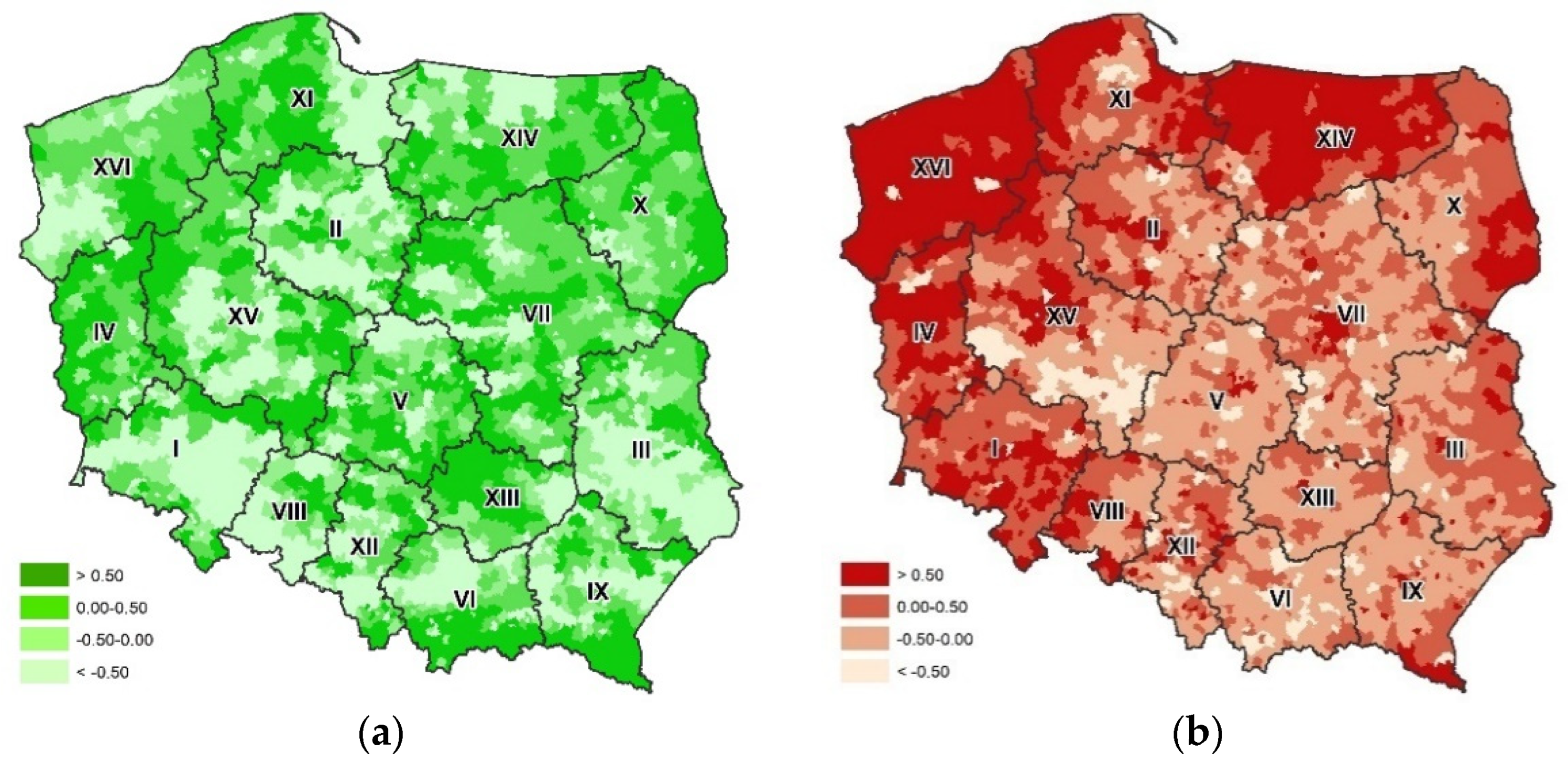
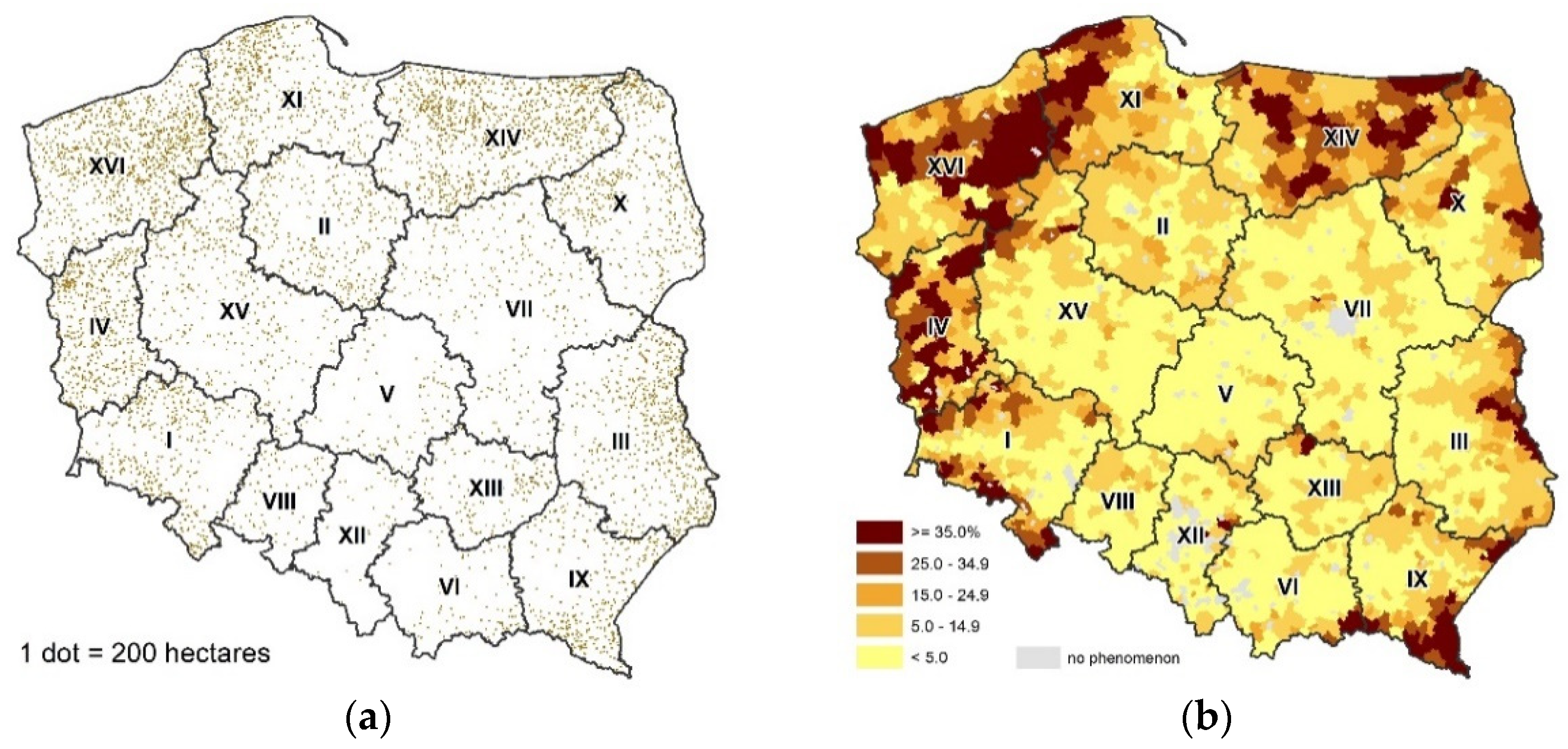
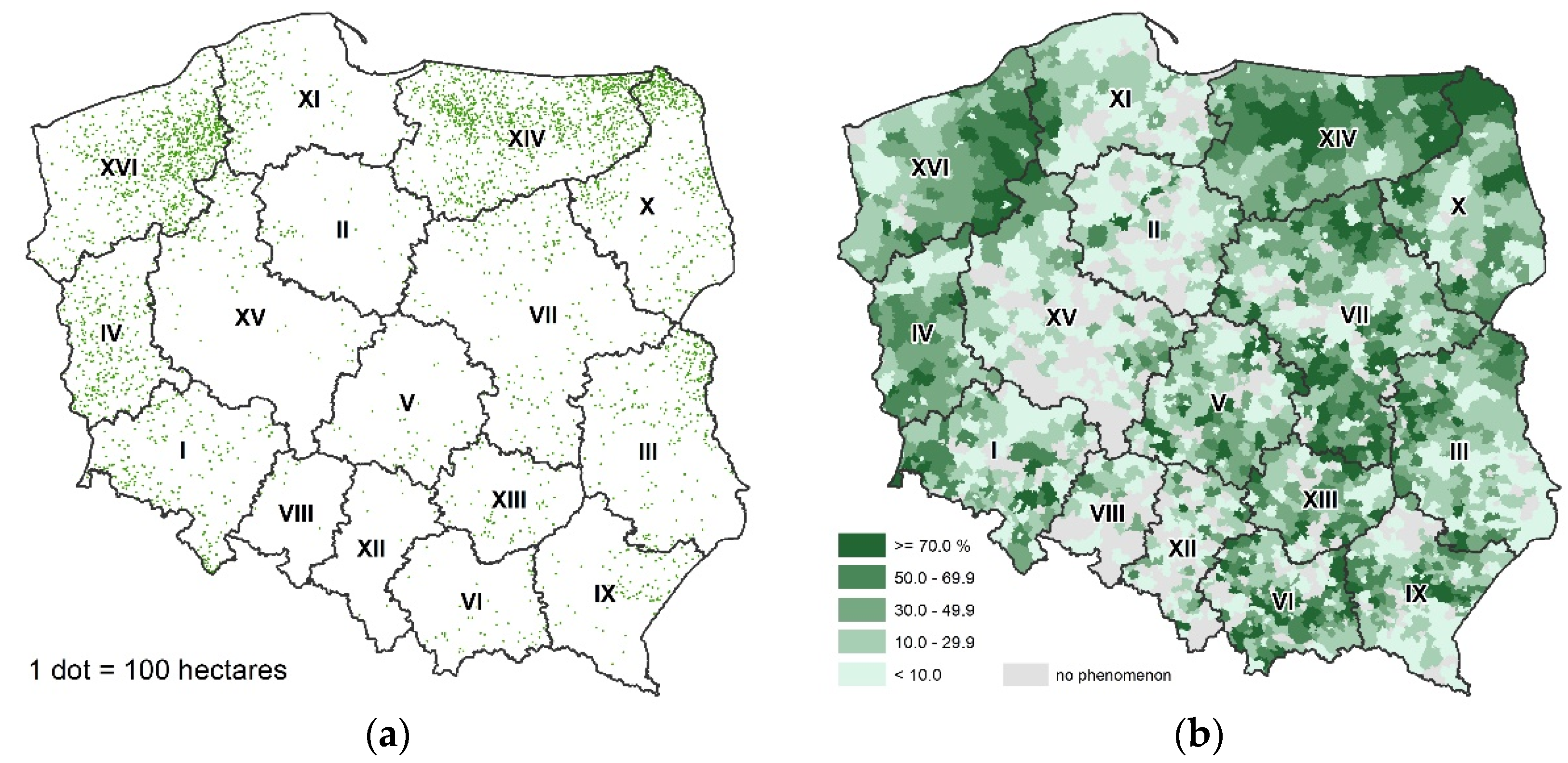
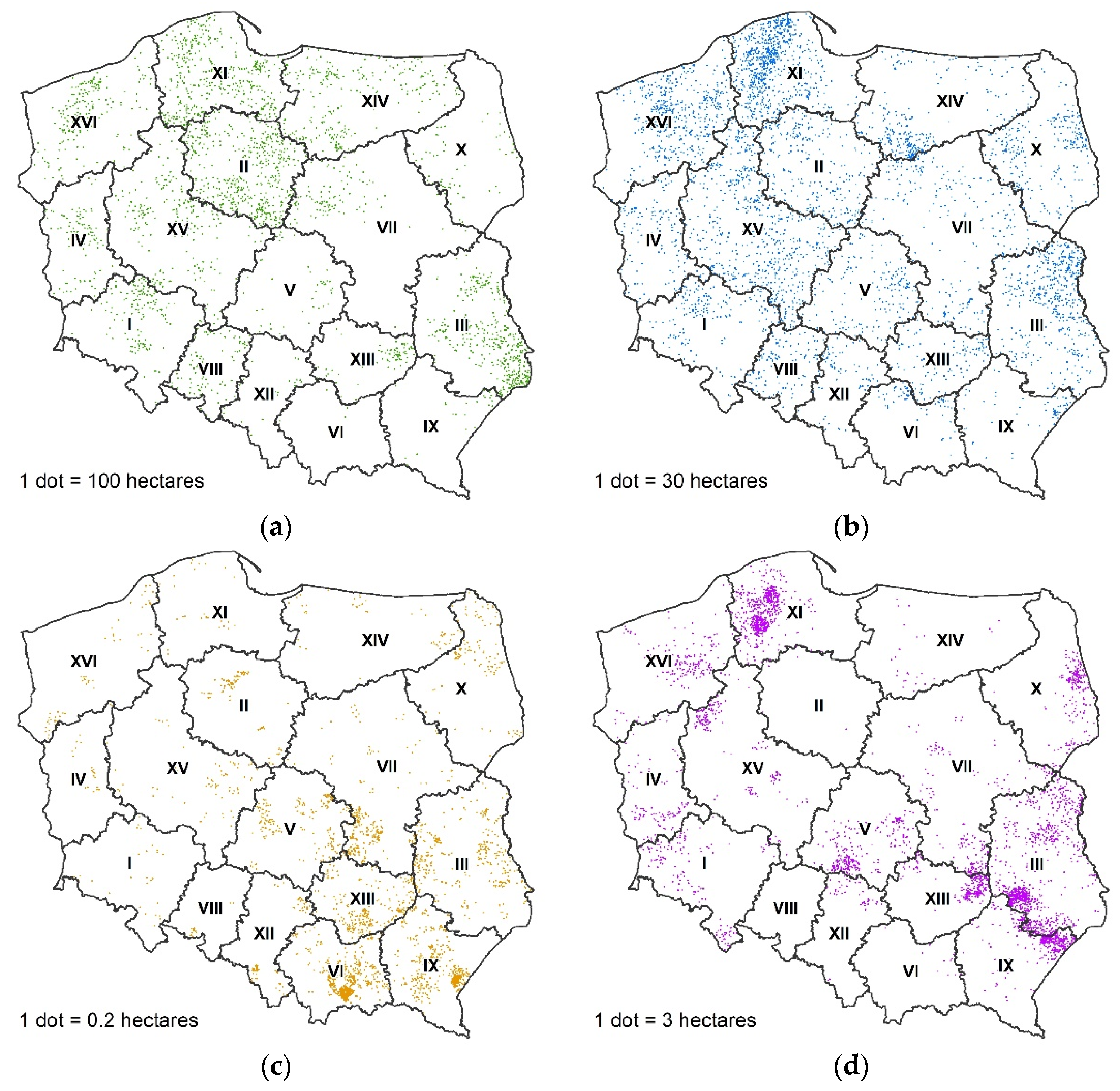
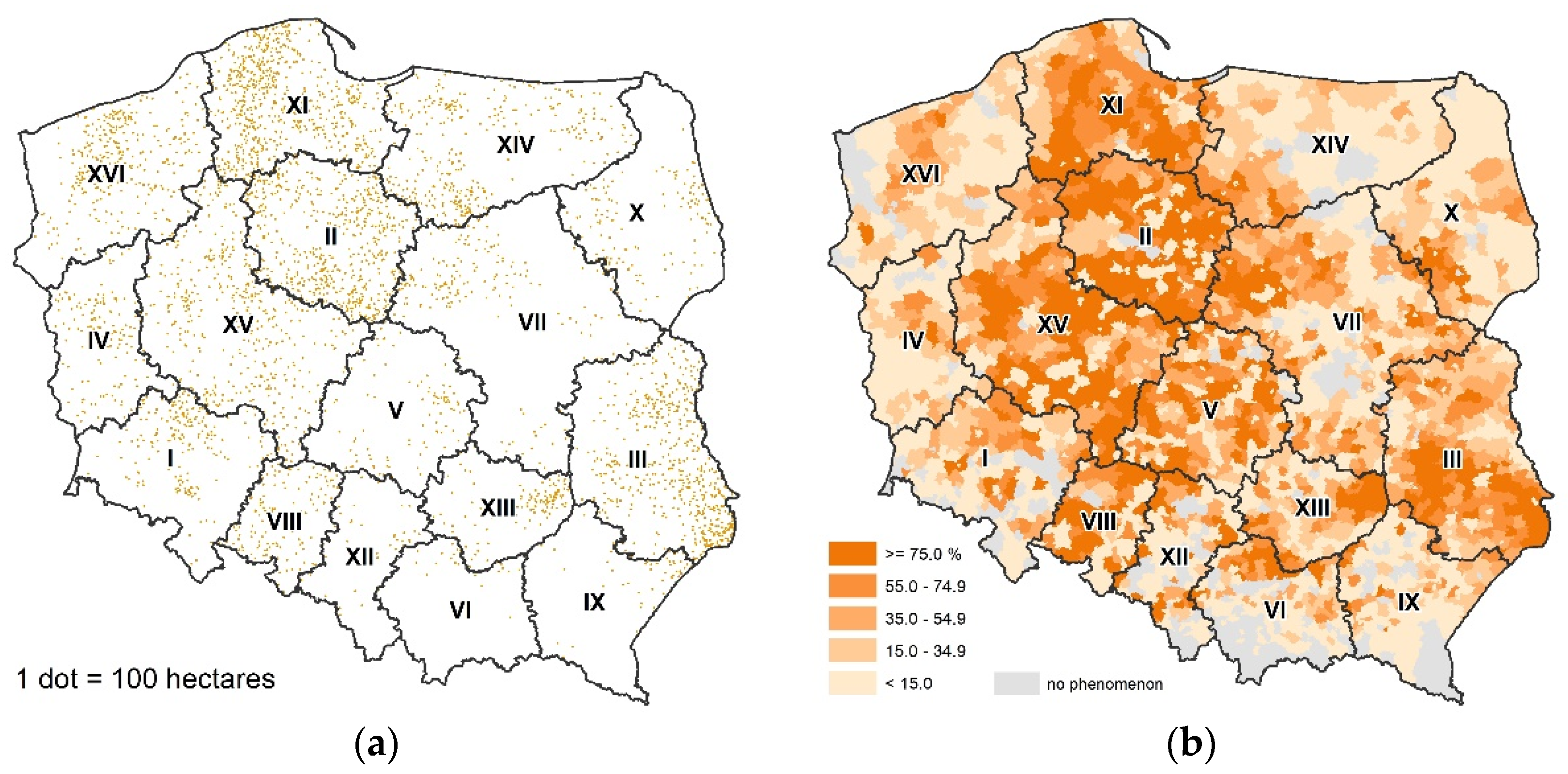
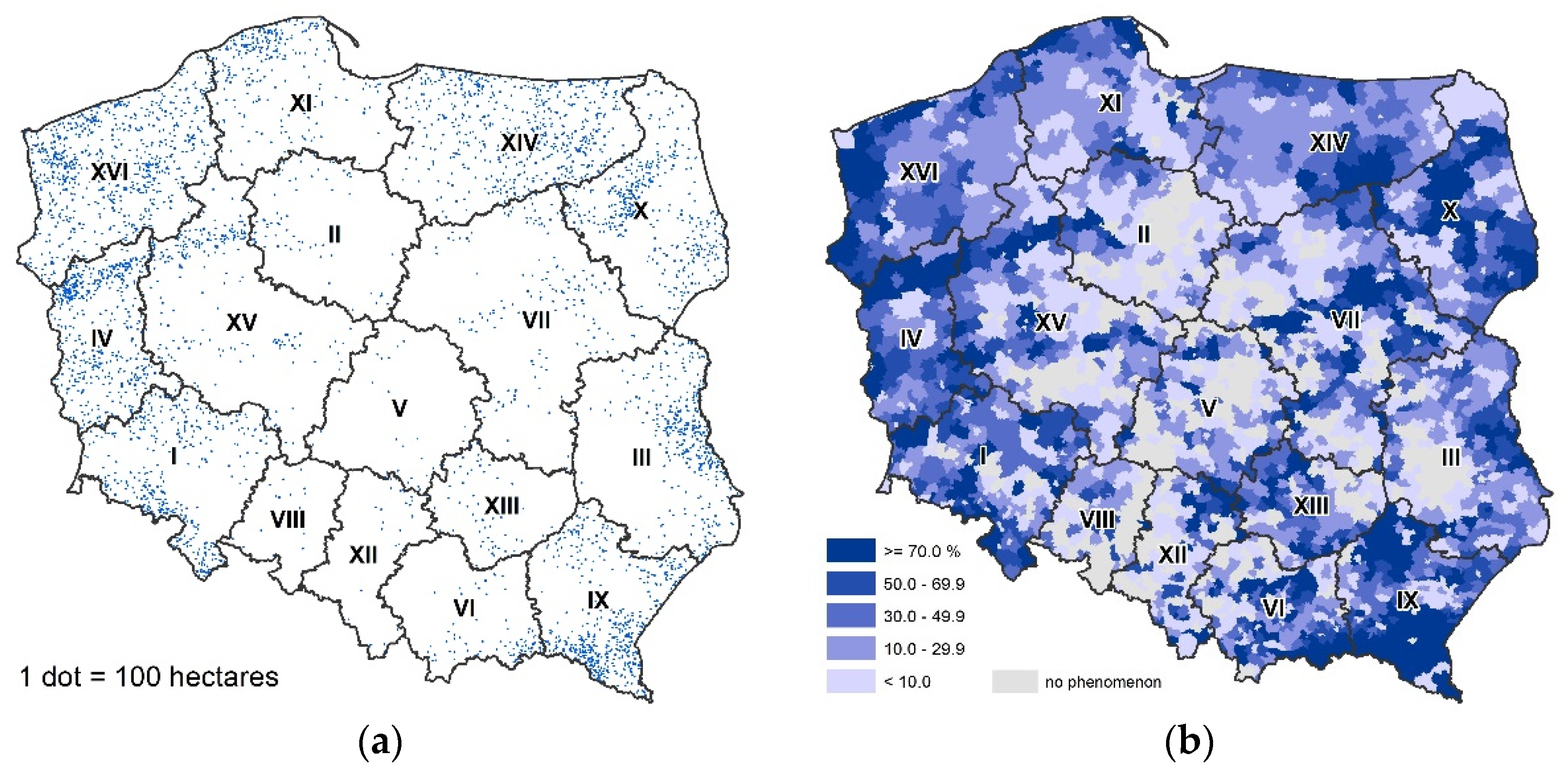

| No. | Spatial Unit | Environmental Conditions | Agricultural Conditions | ||||||
|---|---|---|---|---|---|---|---|---|---|
| Diagnostic Attributes | Synthetic Index | Diagnostic ATTRIBUTES | Synthetic Index | ||||||
| Less Favoured Areas (LFA), as % of Total Area | Protected Areas, as % of Total Area | Soils of Lowest Soil Quality Classes (V, VI), as % of UAA | Average Farm Area | Farms Run by Farmers with Higher Education, as % of Total | Land Productivity (Global Agricultural Production per 1 ha of UAA—A Destimulant) | ||||
| National total | 54.7 | 32.6 | 32.4 | 0.00 | 10.8 | 10.3 | 5.6 | 0.00 | |
| 1 | Lower Silesia | 33.0 | 18.6 | 20.0 | −0.46 | 16.5 | 11.9 | 4.5 | 0.36 |
| 2 | Kuyavia-Pomerania | 39.0 | 32.4 | 20.8 | −0.27 | 16.9 | 9.7 | 6.8 | 0.03 |
| 3 | Lublin | 38.8 | 22.7 | 22.4 | −0.35 | 8.0 | 11.4 | 5.3 | 0.01 |
| 4 | Lubusz | 93.9 | 38.4 | 41.2 | 0.47 | 21.1 | 12.0 | 4.2 | 0.53 |
| 5 | Łódź | 57.9 | 19.5 | 46.7 | 0.07 | 8.1 | 9.5 | 6.8 | −0.24 |
| 6 | Lesser Poland | 36.6 | 53.0 | 30.4 | 0.05 | 4.3 | 8.2 | 5.1 | −0.28 |
| 7 | Masovia | 65.4 | 29.7 | 44.4 | 0.20 | 9.2 | 10.5 | 6.5 | −0.12 |
| 8 | Opole | 15.1 | 27.6 | 21.1 | −0.49 | 18.9 | 9.2 | 5.8 | 0.16 |
| 9 | Subcarpathia | 40.3 | 44.9 | 28.5 | −0.03 | 4.8 | 9.6 | 3.8 | −0.06 |
| 10 | Podlasie | 91.6 | 31.6 | 41.1 | 0.38 | 12.9 | 11.9 | 5.3 | 0.18 |
| 11 | Pomerania | 55.5 | 32.9 | 30.3 | −0.02 | 19.4 | 11.2 | 4.8 | 0.38 |
| 12 | Silesia | 30.6 | 22.0 | 42.0 | −0.16 | 7.9 | 10.4 | 5.7 | −0.09 |
| 13 | Holy Cross | 40.0 | 65.0 | 38.4 | 0.30 | 6.0 | 10.1 | 5.4 | −0.14 |
| 14 | Warmia-Masuria | 76.5 | 46.7 | 22.4 | 0.18 | 22.8 | 13.5 | 4.3 | 0.65 |
| 15 | Greater Poland | 53.5 | 31.6 | 37.4 | 0.05 | 14.7 | 9.0 | 7.9 | −0.16 |
| 16 | West Pomerania | 69.9 | 21.8 | 25.6 | −0.09 | 30.7 | 15.6 | 4.2 | 1.01 |
| No. | Spatial Unit | Subsidised Land | Including Structure | ||||||||
|---|---|---|---|---|---|---|---|---|---|---|---|
| by Support Type | |||||||||||
| Organic Farming—O | Environmental Farming—E | Habitat Farming—H | Sequence | ||||||||
| ha (Thousands) * | as % of Farms | % | Quotient | % | Quotient | % | Quotient | Type | Subtype | ||
| National total | 1284.9 | 9.2 | 32.7 | 2 | 31.8 | 2 | 35.5 | 2 | ES | ES | |
| of which, by province | |||||||||||
| 1 | Lower Silesia | 80.9 | 9.6 | 27.2 | 2 | 25.2 | 1 | 47.6 | 3 | H | H.2 |
| 2 | Kuyavia-Pomerania | 69.0 | 6.7 | 8.1 | 0 | 80.3 | 6 | 11.7 | 0 | E | E.1 |
| 3 | Lublin | 120.9 | 8.9 | 22.3 | 1 | 46.7 | 3 | 31.0 | 2 | E | E.2 |
| 4 | Lubusz | 100.2 | 24.6 | 33.1 | 2 | 14.7 | 1 | 52.2 | 3 | H | H.2 |
| 5 | Łódź | 21.1 | 2.3 | 28.6 | 2 | 54.5 | 3 | 17.0 | 1 | E | E.2 |
| 6 | Lesser Poland | 19.9 | 4.1 | 35.0 | 2 | 15.9 | 1 | 49.1 | 3 | H | H.2 |
| 7 | Masovia | 58.2 | 3.3 | 35.2 | 2 | 33.4 | 2 | 31.4 | 2 | ES | ES |
| 8 | Opole | 17.2 | 3.4 | 9.0 | 0 | 77.6 | 5 | 13.5 | 1 | E | E.1 |
| 9 | Subcarpathia | 64.7 | 12.0 | 15.3 | 1 | 10.3 | 0 | 74.4 | 5 | H | H.1 |
| 10 | Podlasie | 104.1 | 10.2 | 46.7 | 3 | 13.9 | 1 | 39.4 | 2 | E | O.2 |
| 11 | Pomerania | 111.1 | 15.4 | 16.2 | 1 | 58.8 | 4 | 25.0 | 1 | E | E.2 |
| 12 | Silesia | 10.5 | 3.2 | 16.9 | 1 | 46.0 | 3 | 37.2 | 2 | E | E.2 |
| 13 | Holy Cross | 26.1 | 5.3 | 28.4 | 2 | 46.1 | 3 | 25.5 | 1 | E | E.2 |
| 14 | Warmia-Masuria | 204.3 | 21.2 | 55.0 | 3 | 16.4 | 1 | 28.6 | 2 | E | O.2 |
| 15 | Greater Poland | 76.6 | 4.5 | 14.7 | 1 | 54.8 | 3 | 30.5 | 2 | E | E.2 |
| 16 | West Pomerania | 200.0 | 23.8 | 44.1 | 3 | 17.7 | 1 | 38.2 | 2 | E | O.2 |
| of which, assumed determinants | |||||||||||
| ↓ | environmental | 410.5 | 5.7 | 24.0 | 1 | 49.7 | 3 | 26.3 | 2 | E | E.2 |
| ↑ | 874.4 | 13.0 | 36.8 | 2 | 23.4 | 1 | 39.8 | 3 | H | H.2 | |
| correl. coeff. | x | 0.165 | 0.299 | x | 0.122 | x | −0.319 | x | x | x | |
| ↓ | agricultural | 285.4 | 4.6 | 23.0 | 1 | 42.4 | 3 | 34.6 | 2 | E | E.2 |
| ↑ | 999.5 | 12.8 | 35.5 | 2 | 28.8 | 2 | 35.7 | 2 | ES | ES | |
| correl. coeff. | x | 0.397 | 0.346 | x | 0.057 | x | −0.173 | x | x | x | |
| Type | Subtype | No. | Number of Communities | % | Delimitation of Structures of Pro-Environmental CAP Support * | ||
|---|---|---|---|---|---|---|---|
| Organic—O | Environmental—E | Habitat—H | |||||
| Organic farming—O (486 communities) | O.1 | 1 | 117 | 5.1 | 6 | 0 | 0 |
| 2 | 62 | 2.7 | 5 | 1 | 0 | ||
| 3 | 73 | 3.2 | 5 | 0 | 1 | ||
| O.2 | 4 | 54 | 2.4 | 4 | 2 | 0 | |
| 5 | 37 | 1.6 | 4 | 1 | 1 | ||
| 6 | 67 | 2.9 | 4 | 0 | 2 | ||
| 7 | 34 | 1.5 | 3 | 1 | 2 | ||
| 8 | 42 | 1.8 | 3 | 2 | 1 | ||
| Environmental agriculture—E (946 communities) | E.1 | 9 | 472 | 20.7 | 0 | 6 | 0 |
| 10 | 92 | 4.0 | 0 | 5 | 1 | ||
| 11 | 131 | 5.7 | 1 | 5 | 0 | ||
| E.2 | 12 | 61 | 2.7 | 0 | 4 | 2 | |
| 13 | 36 | 1.6 | 1 | 4 | 1 | ||
| 14 | 78 | 3.4 | 2 | 4 | 0 | ||
| 15 | 39 | 1.7 | 1 | 3 | 2 | ||
| 16 | 37 | 1.6 | 2 | 3 | 1 | ||
| Habitat farming—H (631 communities) | H.1 | 17 | 260 | 11.4 | 0 | 0 | 6 |
| 18 | 101 | 4.4 | 1 | 0 | 5 | ||
| 19 | 57 | 2.5 | 0 | 1 | 5 | ||
| H.2 | 20 | 35 | 1.5 | 0 | 2 | 4 | |
| 21 | 74 | 3.2 | 2 | 0 | 4 | ||
| 22 | 33 | 1.4 | 1 | 1 | 4 | ||
| 23 | 34 | 1.5 | 1 | 2 | 3 | ||
| 24 | 37 | 1.6 | 2 | 1 | 3 | ||
| Equal share of directions—ES (219 communities) | 25 | 42 | 1.8 | 0 | 3 | 3 | |
| 26 | 62 | 2.7 | 3 | 3 | 0 | ||
| 27 | 81 | 3.5 | 3 | 0 | 3 | ||
| 28 | 34 | 1.5 | 2 | 2 | 2 | ||
Publisher’s Note: MDPI stays neutral with regard to jurisdictional claims in published maps and institutional affiliations. |
© 2021 by the authors. Licensee MDPI, Basel, Switzerland. This article is an open access article distributed under the terms and conditions of the Creative Commons Attribution (CC BY) license (https://creativecommons.org/licenses/by/4.0/).
Share and Cite
Rudnicki, R.; Wiśniewski, Ł.; Biczkowski, M. A Spatial Typography of Environmentally Friendly Common Agricultural Policy Support Relevant to European Green Deal Objectives. Land 2021, 10, 1092. https://doi.org/10.3390/land10101092
Rudnicki R, Wiśniewski Ł, Biczkowski M. A Spatial Typography of Environmentally Friendly Common Agricultural Policy Support Relevant to European Green Deal Objectives. Land. 2021; 10(10):1092. https://doi.org/10.3390/land10101092
Chicago/Turabian StyleRudnicki, Roman, Łukasz Wiśniewski, and Mirosław Biczkowski. 2021. "A Spatial Typography of Environmentally Friendly Common Agricultural Policy Support Relevant to European Green Deal Objectives" Land 10, no. 10: 1092. https://doi.org/10.3390/land10101092







